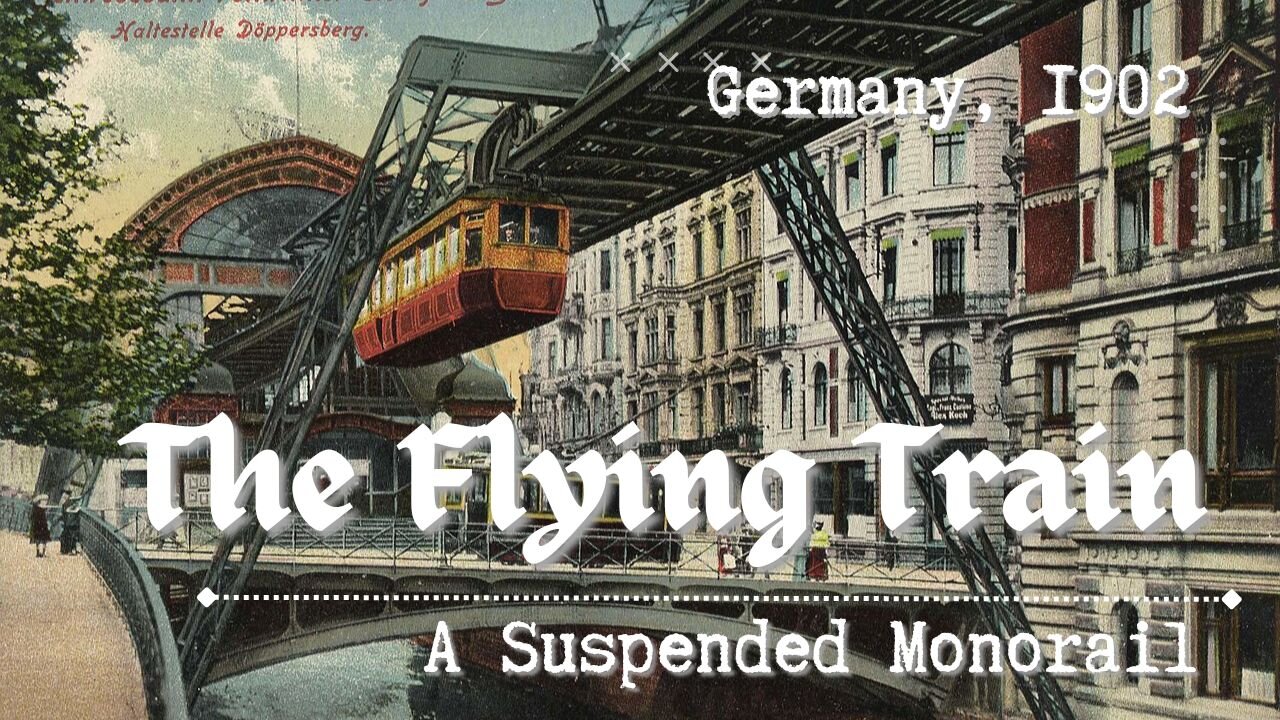Premium Only Content

The Flying Train, An Old World Suspended Rail, Germany, 1902
Note: the city "Wuppertal" didn't yet exist in 1902. Back then, these were a handful of separated cities and towns called "Elberfeld", "Ronsdorf", "Cronenberg", "Vohwinkel" and "Barmen". These cities were united in 1929 under the name "Barmen-Elberfeld" and were renamed into "Wuppertal" in 1930, according to the fact that the cities are located around the Wupper river.
An interesting fact about that train system:
Tuffi was a female circus elephant that became famous in West Germany during 1950 when she accidentally fell from the Wuppertal Schwebebahn into the River Wupper underneath.
On 21 July 1950 the circus director Franz Althoff had Tuffi, four years old, to travel on the suspended monorail in Wuppertal, as a publicity stunt. The elephant trumpeted wildly and ran through the wagon, broke through a window and fell ~12 meters (39 ft) down into the River Wupper, suffering only minor injuries. A panic had broken out in the wagon and some passengers were injured. Althoff helped the elephant out of the water. Both the circus director and the official who had allowed the ride were fined.
The Wuppertal Schwebebahn, also known as The Flying Train, is a historic suspension railway located in Wuppertal, Germany. Here's a detailed look at the NARRATIVE for its construction:
Invention and Initial Proposal: The system was originally named the "Einschienige Hängebahn System Eugen Langen" after its inventor, Eugen Langen. Langen first proposed the technology to Berlin, Munich, and Breslau, but they declined. The towns of Barmen, Elberfeld, and Vohwinkel, situated along the river Wupper, were interested in the technology for its potential to connect their communities.
Construction Timeline: Construction on the Schwebebahn began in 1898 under the supervision of the government's master builder, Wilhelm Feldmann. Emperor Wilhelm II participated in a monorail trial run on 24 October 1900. The railway officially commenced operation on 1 March 1901.
Engineering and Design: The railway is renowned for being the oldest electric elevated railway with hanging cars in the world. It runs along a route of 13.3 kilometers (8.3 miles), at a height of approximately 12 meters (39 feet) above the river Wupper for most of its length, and about 8 meters (26 feet) above the valley road for the remaining section.
The Wuppertaler Schwebebahn is a suspension railway in Wuppertal, Germany. The line was originally called the German: Einschienige Hängebahn System Eugen Langen named for its inventor, Eugen Langen. It is the oldest electric elevated railway with hanging cars in the world and is a unique system in Germany.
Langen first offered the technology to the cities of Berlin, Munich, and Breslau who all turned it down. However, the towns of Barmen, Elberfeld, and Vohwinkel along the banks of the river Wupper were intrigued by the technology’s ability to connect their communities. The elevated tracks and stations were built between 1897 and 1903; the first track opened in 1901. The railway line is credited with growth of the original cities and their eventual merger into Wuppertal. The Schwebebahn is still in use as a local public transport line, moving 25 million passengers annually, per the 2008 annual report. New rail cars were ordered in 2015, called Generation 15, and the first new car went into service in December 2016.
The Wuppertaler Schwebebahn had a forerunner: in 1824, Henry Robinson Palmer of Britain presented a railway system which differed from all previous constructions. It was a low single-rail suspension railway on which the carriages were drawn by horses. Friedrich Harkort, a Prussian industrial entrepreneur and politician, loved the idea. He saw big advantages for the transportation of coal to the early industrialized region in and around the Wupper valley. Harkort had his own steel mill in Elberfeld; he built a demonstration segment of the Palmer system and set it up in 1826 on the grounds of what is today the Wuppertal tax office. He tried to attract public attention to his railway plans.
Construction on the actual Schwebebahn began in 1898, overseen by the government's master builder, Wilhelm Feldmann. On 24 October 1900, Emperor Wilhelm II participated in a monorail trial run.
SOURCE
Denis Shiryaev
-
 16:25
16:25
The Aquarius Bus
5 months agoSalt Lake City, Utah. 1860. Built or Found? Again, where are the people?
1.52K6 -
 LIVE
LIVE
The Quartering
1 hour agoTrump Says "Be Cool" (It Works), China Tries HUMILATING America (It Doesn't)
37,560 watching -
 1:25:05
1:25:05
Russell Brand
3 hours agoTrade War Inferno: Trump Torches China with 124%—Xi Hits Back Hard – SF563
122K30 -
 47:29
47:29
Sean Unpaved
3 hours agoMike Malone's Shocking Departure From Denver! & Masters Tournament Favorites
32.1K -
 LIVE
LIVE
Dr Disrespect
3 hours ago🔴LIVE - DR DISRESPECT - WARZONE VERDANSK - THE NUKE
3,831 watching -
 LIVE
LIVE
Keepslidin
29 minutes ago5K START | ROAD TO 100K | Mother.land
87 watching -
 1:03:12
1:03:12
Timcast
3 hours agoChina RETALIATES With 84% Tariff, Trump REFUSES To Surrender, Gen Z IN CRISIS
163K131 -
 LIVE
LIVE
Crypto Power Hour
5 hours agoFinancial Concepts in Crypto – How Value Moves
69 watching -
 LIVE
LIVE
Silver Dragons
1 hour agoSTACKING MANIA - Dealer Responds to the Silver & Gold MADNESS
190 watching -
 37:14
37:14
CatfishedOnline
3 hours agoIs This Woman Helping A Romance Scammer Steal Money From Victims?
3.62K